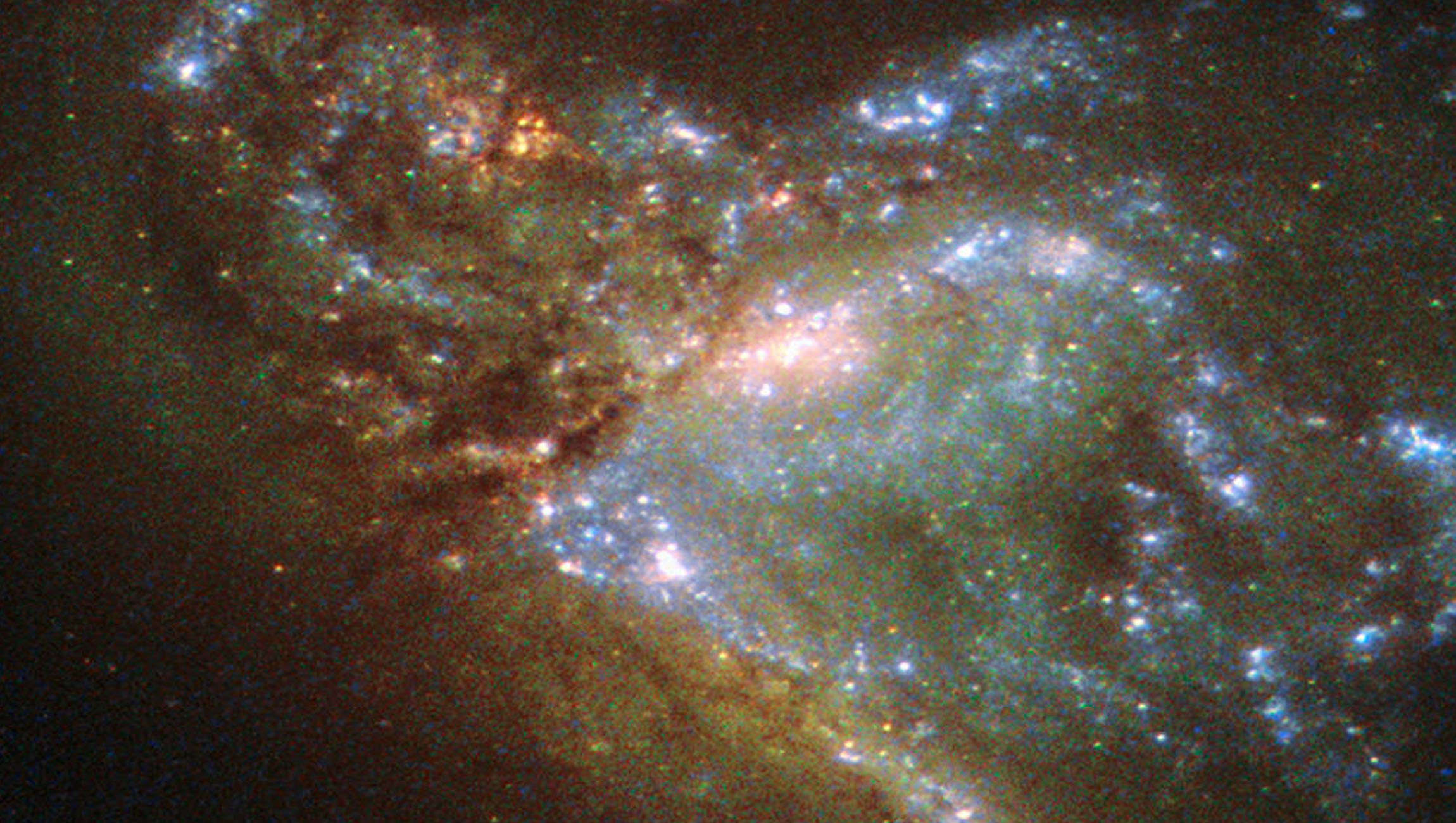Create a free profile to get unlimited access to exclusive videos, sweepstakes, and more!
Dark matter is missing from these galaxies, and the reason why is crawling out of the dark

How can you even tell something is missing when you can’t even see it?
Dark matter has never been seen even though more of it is thought to exist in the universe than baryonic matter, or visible matter as we know it (that’s six times more dark matter). It is thought to form an invisible halo around a galaxy. So why did a bizarre pair of galaxies have a deficit of this invisible matter? After theoretical physicist Hai-Bo Yu and his research team observed these galaxies and created simulations of them, they were able to reveal why these galaxies’ stellar masses had so much less dark matter than expected.
“Astronomical observations show that DF2 and DF4 are likely satellite galaxies of the massive elliptical galaxy NGC 1052 (above), and we knew that tidal interactions between a satellite galaxy and a massive host galaxy could lead to significant mass loss of the satellite,“ Yu, who led a study recently published in Physical Review Letters, told SYFY WIRE. “So the dark matter deficiency of DF2 and DF4 is likely due to tidal mass loss.”
Objects in space can suffer anything from losing matter to getting completely shredded when they interact with other, larger objects that have a gravitational advantage. Just think of binary stars that orbit each other in a death spiral until one gets consumed by the other or they both collapse. Galaxies NGC 1052-DF2 and NGC 1052-DF4 are thought to be satellite galaxies of the massive NGC1052. They probably had the misfortune of ending up too close to NGC1052, whose tidal forces stripped them of their dark matter. Both galaxies were initially still expected to be contained within a halo of dark matter held in place by gravity, but their gravitational forces seem to have been no match for their monster host galaxy.
“We cannot see dark matter directly. However, visible stars are tracers of gravitational potential that they experience,” said Yu. “Thus, the amount of dark matter can be inferred from stellar motion. Roughly speaking, if stars move fast, it indicates that the mass of dark matter is high.”
NGC 1052’s galactic tidal forces are believed to have stripped away the dark matter of the satellite galaxies, which the larger galaxy supposedly devoured. The beast that lurks 62 million light years away is now even more massive while its minions are less massive (even though the missing mass cannot be seen). The thing about dark matter is that its particles are assumed to be incapable of interacting by the cold dark matter theory (CDM). While this has been the dominant theory, the newer self-interacting dark matter theory (SIDM) assumes that dark matter particles can collide when they are close to a galactic core, which suggests different distributions of dark matter in the guts of a galaxy than CDM does. Yu is obviously in favor of SIDM.
“We considered both prevailing cold dark matter (CDM) theory and newer self-interacting dark matter (SIDM) theory, and found that SIDM agrees with the observations much better,” he said. Then our work supports the idea that dark matter has strong self-interactions, similar to the nuclear interactions with which we are familiar. This is a significant deviation from the prevailing CDM theory.”
Yu and his team at the University of California Riverside needed all the observational data on DF2, DF4, and NGC 1052 they could possibly get to figure out why there was 300 times less dark matter in the smaller galaxies. Dark and baryonic matter distributions, galactic age and the distance between NGC 1052 and the smaller galaxies all factored into the simulations. They then created a model of the system with numerical simulations and used that information as input, running several versions to be sure the simulated galaxies came as close as possible to the real ones.
The dark matter haloes that resulted from the DF2 and DF4 simulations were indeed each 300 times smaller than what their masses before the interaction with NGC 1052 were expected to be, but their stellar mass was not affected much. This is how Yu and his team figured out where the missing dark matter must have gone. So are dark matter and baryonic matter affected differently by tidal forces, besides the fact that the effects of these forces on one can at least be seen by a telescope if not by the human eye?
“For the purpose of this study, we can think tidal forces affect dark matter and baryonic matter in a similar way, such as the stripping away of mass,” said Yu. “However, since dark matter and baryonic matter have different distributions in galaxies, their final consequences are different. The dark matter distribution is much more diffuse and extended than the baryon distribution. This explains why the tidal mass loss is much more significant for dark matter.”
After this breakthrough, expect more about the enigmatic stuff otherwise known as dark matter to be brought to light.


























